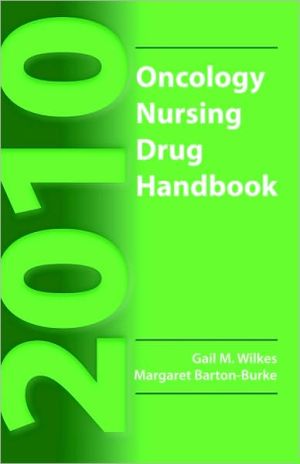2010 Oncology Nursing Drug Handbook
Written expressly for nurses caring for patients with cancer, the 2010 Oncology Nursing Drug Handbook uniquely expresses drug therapy in terms of the nursing process: nursing diagnoses, etiologies of toxicities, and key points for nursing assessment, intervention, and evaluation. An essential reference updated annually, the text provides valuable information on effective symptom management, patient education, and chemotherapy administration.\ Completely revised and updated, the 2010 Oncology...
Search in google:
Written expressly for nurses caring for patients with cancer, the 2010 Oncology Nursing Drug Handbook uniquely expresses drug therapy in terms of the nursing process: nursing diagnoses, etiologies of toxicities, and key points for nursing assessment, intervention, and evaluation. An essential reference updated annually, the text provides valuable information on effective symptom management, patient education, and chemotherapy administration. Doody Review Services Reviewer:Celeste Taylor-Ryman, BSN, CPON(University of New Mexico Hospital)Description:This comprehensive drug handbook incorporates all aspects of oncology drugs, including anatomy, physiology, chemistry, clinical drug trials, and nursing diagnosis, with up-to- date references. The format is excellent for understanding drugs, therapies, side effects, and pathophysiology. Purpose:The purpose is to assist nurses in the pharmacological management of patients with cancer, and all of the related issues, with the goal of fostering their long-term survival. The authors have produced an outstanding resource of well-researched and intelligently presented information.Audience:Although written primarily for nurses, pharmacists and physicians will find some aspects of this book valuable. Features:The book is divided into three areas related to oncologic drug usage -- treatment, management, and complications - and comprehensively deals with each area for each drug. Non-chemotherapy drugs such as antibiotics and others are also discussed. The authors employ a variety of innovative methods in the book, including using nursing diagnoses to explain side effects and treatment and listing uses of the drugs with different cancers in a very instructive way. Pathophysiology is incorporated in a clear and easy to understand manner, almost like a textbook.Assessment:This is the highest quality nursing drug book I have seen and it should be a model for others. It includes an extensive section on safety issues and guidelines for the handling of chemotherapy. I appreciate the fact that I also can use it as a reference for non-chemotherapy drugs. This is a state-of-the-art representation of the nursing perspective on oncologic drugs and related care.
\ From The CriticsReviewer: Celeste Taylor-Ryman, BSN, CPON(University of New Mexico Hospital)\ Description: This comprehensive drug handbook incorporates all aspects of oncology drugs, including anatomy, physiology, chemistry, clinical drug trials, and nursing diagnosis, with up-to- date references. The format is excellent for understanding drugs, therapies, side effects, and pathophysiology. \ Purpose: The purpose is to assist nurses in the pharmacological management of patients with cancer, and all of the related issues, with the goal of fostering their long-term survival. The authors have produced an outstanding resource of well-researched and intelligently presented information.\ Audience: Although written primarily for nurses, pharmacists and physicians will find some aspects of this book valuable. \ Features: The book is divided into three areas related to oncologic drug usage — treatment, management, and complications - and comprehensively deals with each area for each drug. Non-chemotherapy drugs such as antibiotics and others are also discussed. The authors employ a variety of innovative methods in the book, including using nursing diagnoses to explain side effects and treatment and listing uses of the drugs with different cancers in a very instructive way. Pathophysiology is incorporated in a clear and easy to understand manner, almost like a textbook.\ Assessment: This is the highest quality nursing drug book I have seen and it should be a model for others. It includes an extensive section on safety issues and guidelines for the handling of chemotherapy. I appreciate the fact that I also can use it as a reference for non-chemotherapy drugs. This is a state-of-the-art representation of the nursing perspective on oncologic drugs and related care.\ \ \ \ \ From The CriticsReviewer: Celeste Taylor-Ryman, BSN, CPON(University of New Mexico Hospital) \ Description: This comprehensive drug handbook incorporates all aspects of oncology drugs, including anatomy, physiology, chemistry, clinical drug trials, and nursing diagnosis, with up-to- date references. The format is excellent for understanding drugs, therapies, side effects, and pathophysiology. \ Purpose: The purpose is to assist nurses in the pharmacological management of patients with cancer, and all of the related issues, with the goal of fostering their long-term survival. The authors have produced an outstanding resource of well-researched and intelligently presented information.\ Audience: Although written primarily for nurses, pharmacists and physicians will find some aspects of this book valuable. \ Features: The book is divided into three areas related to oncologic drug usage — treatment, management, and complications - and comprehensively deals with each area for each drug. Non-chemotherapy drugs such as antibiotics and others are also discussed. The authors employ a variety of innovative methods in the book, including using nursing diagnoses to explain side effects and treatment and listing uses of the drugs with different cancers in a very instructive way. Pathophysiology is incorporated in a clear and easy to understand manner, almost like a textbook.\ Assessment: This is the highest quality nursing drug book I have seen and it should be a model for others. It includes an extensive section on safety issues and guidelines for the handling of chemotherapy. I appreciate the fact that I also can use it as a reference for non-chemotherapy drugs. This is a state-of-the-art representation of the nursing perspective on oncologic drugs and related care.\ \








